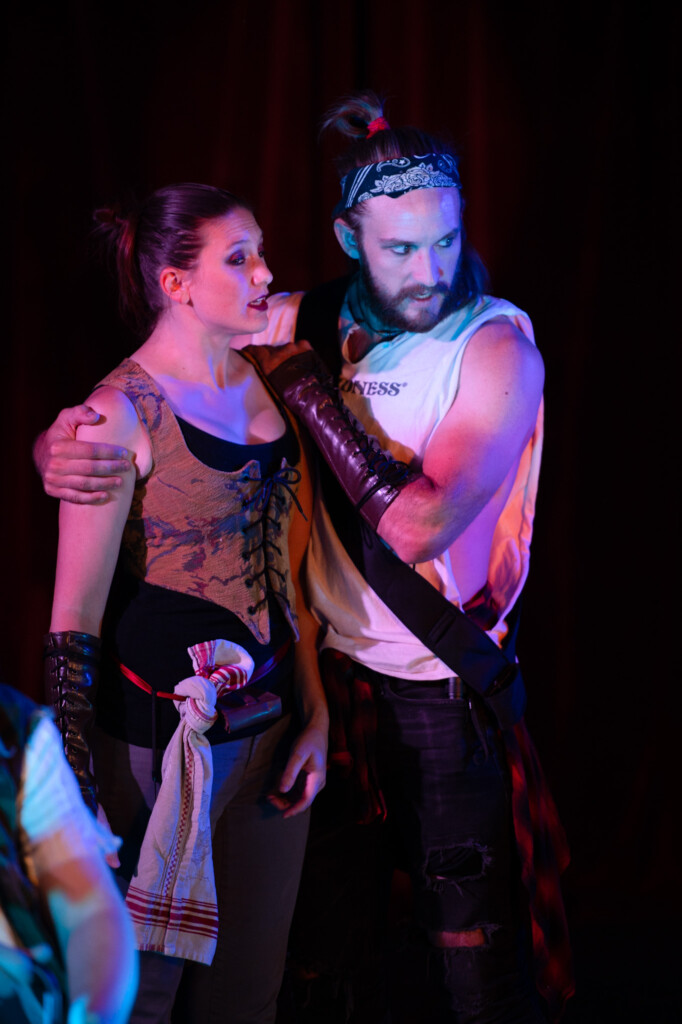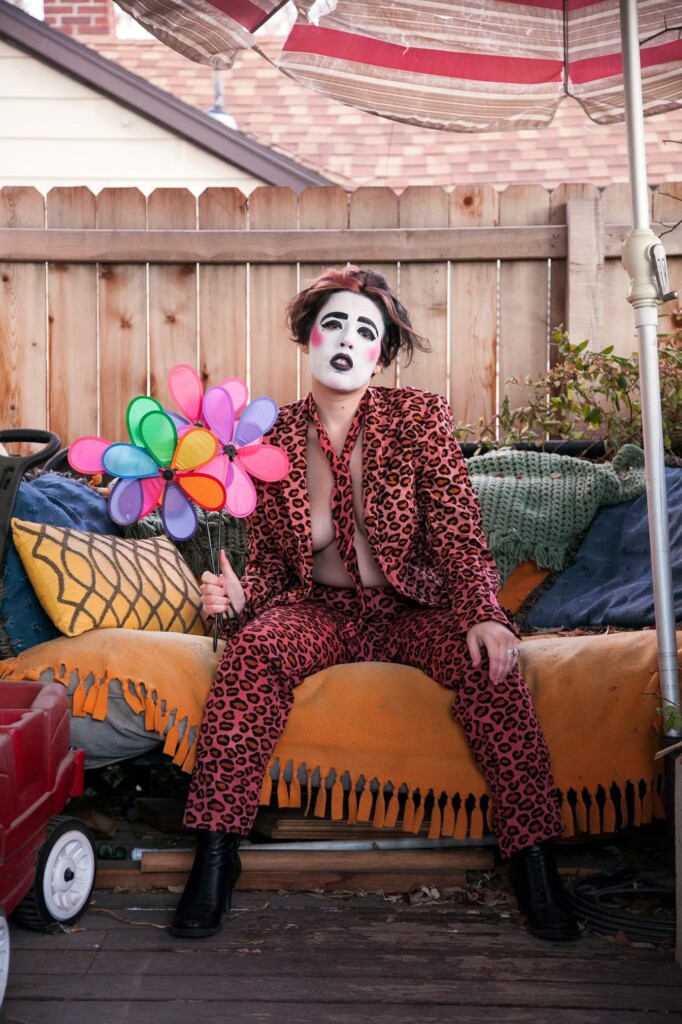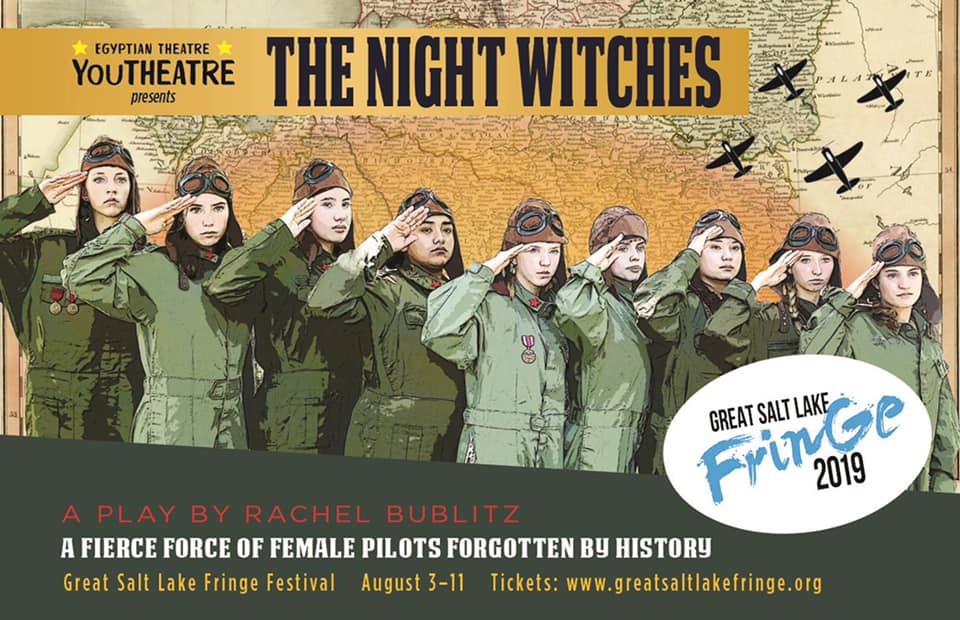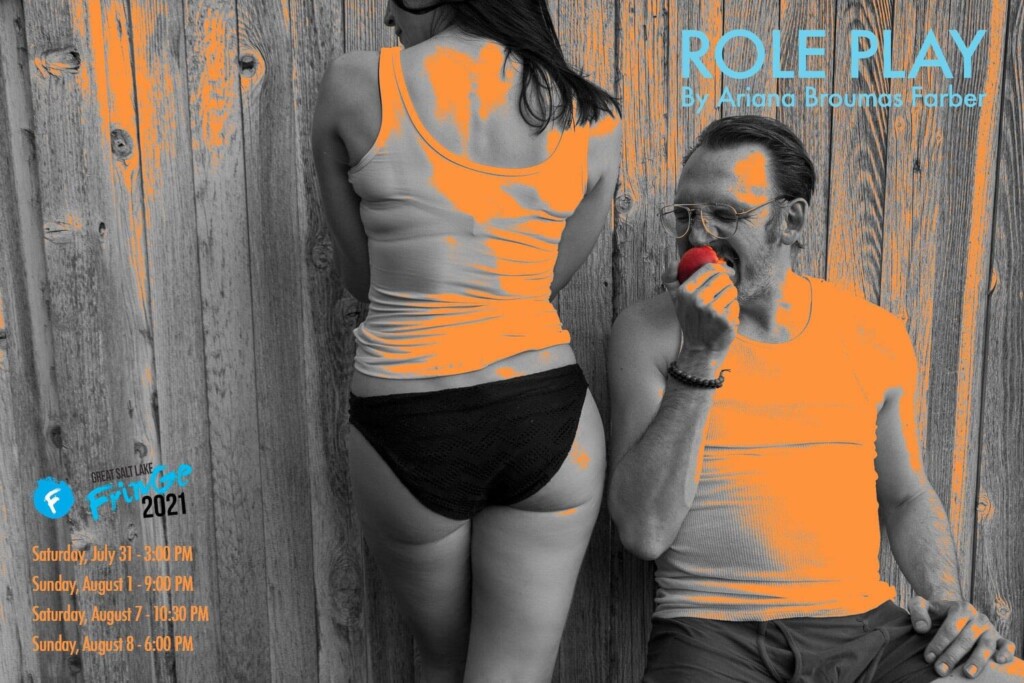EDITOR’S NOTE: This is Part 1 of a two-part feature about the Great Salt Lake Fringe festival’s 10th anniversary, This year’s festival will comprise two weekends of performances (July 26-28 and August 2-4) at the Alliance Theater, connected to the Utah Arts Alliance, at Trolley Square. See Part 2 here, for a summary of this year’s festival shows.
Founded a decade ago as part of a Westminster University enterprise project, the Great Salt Lake Fringe (GSLF) festival has been admirably resilient flexing with having staged the annual event in three different parts of Salt Lake City, managing through the pandemic and developing a brand that has gained the loyal support of a solid core of members from Utah’s performing arts community. As a creative incubator, GSLF has remained true to the ideals of that first independent festival 77 years ago in Edinburgh, where four criteria are essential: no prior professional performing arts experience required, no juried selection, no pretentiousness or poseurs and no costly, complicated professional production values.
To reiterate a point made in past years at The Utah Review, Fringe is a model of artistic equity in terms of treatment and access. All of the ticket sales revenue is paid out to each performer or group, based on their cumulative audience numbers. Because the Fringe model puts every performer on as equal a playing level as possible, it is up to the individual show creators and performers to promote and advertise their work. From year to year, many Fringe participants have stepped up their social media and public relations game, which has whetted the public’s appetite for viewing work that is being presented for the first time.
In a 2021 Facebook post, Utah playwright Morag Shepherd, who has participated several times in the Great Salt Lake Fringe Festival, wrote, “For those who do not have the luxury or privilege to make a living wage doing the thing they love, Fringe is this beautiful space where artists, young and old, can try out some shit and see what sticks. It’s mostly affordable. And to the kids out of college who are dipping in their pockets and losing a lot to make this work — I see you.”
Today, there are more than 200 Fringe festivals around the world”. As with the vaudeville circuit of the early 1900s, some artists tour the fringe every year,” Nicole Gluckstern, a traveling technician and stage manager, explained in a 2023 Roadtrippers feature. “Some make enough from their fringe funds to make a living, but more often they are supplementing jobs that have summer breaks built in. The circuit is filled with substitute teachers, performance professionals, freelance directors, and lecturers. But even for these folks, fringe can be more than just a sideline; it’s a lifestyle.
The global concept brand of Fringe is now nearly 75 years old, having originated in Edinburgh. GSLF grew steadily, since it was founded in 2015 by Michael and Nina Vought, faculty members at Westminster College. The first event was four days, with 29 shows, an art gallery, a concert series, and more than 100 performances. It was doubled in length for the following year and continues to be offered on two consecutive weekends.
Likewise, because Fringe originated through the efforts of Westminster College faculty, staff and students, volunteers have always been essential. They have included those with technical staging experience, along with students from the private liberal arts college who have gained valuable hands-on experience with event planning and arts management. In previous years, for example, Melissa Salguero, as box office manager, implemented an easy-to-use digital ticketing system. Salguero and Aidan Powell Croft, another Fringe alum and past performer, also The Well Spoken, a comedy piece, for a Bonneville Theatre Company production. And, Shianne Gray, founding co-director who continues to work with Fringe, once directed a theatrical comedy piece: Wild Swimming.
The festival was held at various Sugar House locations during its first three years. In 2016, its second year, GSLF already had taken a form that is similar to the 2024 version: theater, dance, music, aerial arts, puppetry, magic and spoken word and with a particular focus on accessible run times and rapid-fire pieces that require minimal technical setup. Unlike traditional theater, audiences can see multiple shows in a single evening.
One of the performers that year (2016), Andrew Nadon said in an interview with The Utah Review, “I decided to do the Fringe for two reasons; exposure and to spread around some much needed positive energy. I want people to leave my show feeling upbeat and enthusiastic to share those positive feelings with everyone they meet on life’s journey. When it comes down to it, we are all we have, so let’s brighten our future!” He performed under the stage name aLittleMentalist, showcasing a form of magic that was unfamiliar to many Utah audiences at the time – mentalism. Popularized internationally by names such as Derren Brown and Uri Geller, the performance style was known for its focus on intuition and clever psychological exploits, including mind reading, predictions and imagination “to mess with minds in the best, and most surprising of all possible ways,” as he explained it at the time.
For five years, Fringe was held at The Gateway on the west side of downtown Salt Lake City, with the venues staged in vacant retail outlets, spread across the complex. In 2018, pre-festival ticket sales were quintupled over 2017. Before the pandemic, GSLF had clearly found its momentum, especially in its fifth year, In 2019, with numerous sold-out performances in its five venues at The Gateway, GSLF saw ticket sales up more than 34 percent from 2018, topping the 3,200 mark for the first time in the event’s history. Payout to the performers totaled approximately $22,000, up nearly 46 percent in the same period.
As with more than 200 Fringe festivals around the world, GSLF went entirely online in 2020. “The virtual format allows even more creativity than usual,” Jay Perry, co-festival director, told The Utah Review that year. “The gamut of available genres is pretty close to what we have had in other years, thanks especially to Zoom video and conferencing technologies.” He added, “the performers really are in uncharted territory for finding ways to explore the magic of live theater in the virtual format. We wanted to do something because we just felt like we needed to give some place for artists to gather – now more than ever.”
His colleague echoed the sentiment. Festival co-director Shianne Gray explained one of the greatest strengths of the Fringe concept is that the “free spirit translates very well to a virtual medium; a nontraditional setting. And, we saw in the submissions how everyone responded to that challenge in droves.”
In SLC, the results during the all-streaming festival in 2020 were heartening: the schedule of 38 shows was viewed more than 5,000 times from 48 states and 25 countries. Many individual performers raised tips and donations and GSLF organizers noted the amounts per show were comparable to an average payout for a live Fringe performance.

In 2021, the festival also drew the largest number of submissions, as it staged a record 52 shows, presented both live and online. In 2022, after two years when the pandemic significantly curtailed GSLF’s visibility and presence in various ways, the festival returned with strong results. Representing both weekends of the festival, 2,351 tickets were sold, a good showing for the event’s first full in-person presentation since 2019.
The history of the performing arts is filled with numerous examples about avant-garde, fringe, idiosyncratic and peculiar works of creative expression that originated in humble, minimalistic venues but then later became part of the permanent canon of artistic excellence. Some of the performances are polished and impressive and others less so. But, the fringe festival’s greatest draws are the artistic energy and the daring risks performers take to present their work willingly to new audiences. Every show runs an hour or less.
The greatest success story that can happen in any fringe festival is for a performer or organization to expand and grow its creative entrepreneurial presence in the community. That standard was immediately established in the first year (2015) with Ruff! by Jenifer Nii was premiered as part of Plan-B Theatre’s Free Elementary School Tour (FEST). (Trivia bit: Tyson Baker who acted in the 2015 production returns this year to direct the world premiere at Fringe of Matthew Ivan Bennett’s Non).
As Jerry Rapier, Plan-B’s artistic director, explained in an interview with The Utah Review in 2015, “Having Fringed twice before (Toronto’s Fringe Festival in 2006 and the New York International Fringe Festival in 2013) I was excited to learn that someone had taken the reigns and jumped off the Launch-A-Local-Fringe cliff. Over the years, I have had many conversations about the lack of Fringe here in Salt Lake City but they just remained conversations. It’s a daunting task.”
His comments at the time turned out to be prescient and key to comprehending the significance of GSLF’s 10th anniversary:
There’s a lot of talk about the depth and breadth of talent in this city. There’s also a lot of talk about the lack of the depth and breadth of opportunity for the talent in this city. And there’s also a lot of talk about how folks would like to see things done differently. A Fringe is a gift to this community to address all of those things. It’s an invitation to the community at large to experience the arts in a way they may not have before. And it’s an opportunity for artists and companies to be seen in a different way (i.e. Plan-B creating and staging theater for youth)
In fact, Gray, one of the Great Salt Lake Fringe Festival founders, briefly served as an intern for Plan-B.
With various memorable productions, Fringe has launched new performing arts organizations in the Salt Lake City metropolitan area. They include, most recently, Immigrant’s Daughter Theatre. While theatrical productions of new plays which run an hour or less have comprised a major portion of Fringe’s programming in the first decade, there have been notable examples of other types of performing arts programming. In 2022, The Combat, a superb adaptation of an early 17th century protean opera that was written in the form of a dramatic madrigal was presented by Opera Contempo and NEXT Ensemble. The adaptation brought the work to the 21st century with the arena of combat taking the shape of a flame war on social media.
Also in that same year for Fringe, Veteran actor Sarah Shippobotham, well known in the Utah performing arts scene, presented Can I Say Yes to that Dress?. The award-winning one-actor show received a full production last fall at Salt Lake Acting Company, garnering substantial critical acclaim. A 2021 solo show, also an award winner at Fringe, Strangers: a homo’s odyssey, by Tom Roche, was accepted for the United Solo Screen Festival and has been made available for production elsewhere, including a recent performance at South Dakota State University.
Fringe premieres have led to other notable appearances. Shepherd’s play Do You Want to See Me Naked?, a solo work that featured actor Elizabeth Golden, was performed in 2018 at the United Solo Festival, the world’s largest gathering of solo theatrical works, held annually in New York City. The comedy show, with elements of Mormonism in its themes, drives messages challenging not just modesty but also how religious and social conventions mercilessly leave many individuals so ambivalent, or even ashamed, and thoroughly disconnected from their bodies. The play premiered at the GSLF in 2017.
Madazon Can-Can, an ingeniously multifaceted burlesque artist who has provided some of GSLF’s most memorable award-winning shows in recent years, is working as a full-time artist with one of the most active schedules that would be the envy of any independent creative producer. Perhaps the one performer who has epitomized the Fringe creative brief so effectively and so comprehensively, Madazon explained their work in an interview published elsewhere: “I go after what I want and I don’t let anything stop me. I’m a producer, emcee, performer, and teacher and often it is known that I speak some heavy truths even if folks don’t want to hear them. My honest approach, undeniable integrity, and accountability are what keep me booked in even the most unlikely of circumstances and keep me traveling and on tour all throughout the year. I’m also a kinkster and people know where to find me for lessons, coaching, and services of the dominatrix kind.”
Their Can-Cantasia virtual show for GSLF in 2020 was brilliant. As The Utah Review noted at the time, “This year’s show excels with Madazon’s exquisite skills at making penetrating statements about the contemporary scene while providing the same generous bounty of entertainment that last year’s Fringe production offered. Madazon strikes the right pitch in every scene of this drag, burlesque and clown fantasia that becomes a cause célèbre for thinking about the artist as human and the uniquely terrifying circumstances of sustaining that passion and livelihood in this unprecedented pandemic time.”
Others who have leveraged effectively their Fringe experiences into larger works, presented in formal settings and with additional funding include choreographers and dance artists such as Dan Higgins; Dat Nguyen, who now lives and performs in Vietnam, and Cat + Fish Dances and the Interdisciplinary Arts Collective, which Indigo Cook, who also is a master’s degree student in the dance program at Duke University, founded and established at Westminster. Utah’s former Sackerson theatrical company was established by way of its Fringe appearances. In 2018, Prufrock Productions produced the regional premiere of Marty Has Cancer, a play by Austin Archer, a work that premiered earlier that summer at the Hollywood Fringe.

From both the vantage of student-focused and professional shows, Fringe slates have included a significant number of socially conscious productions on timely topics – a good barometer of what is most present in the minds of many creative producers. Topics have touched on elderly care, queer identity, sexual assault, family grief, teen suicide, enuvrinmentalism, workplace politics, sexual harassment, human migration and gun violence. Comedy and gentle humor also are present in various shows. There are many artists representing marginalized gender identities as well as LGBTQIA+ and BIPOC communities.
Some one-person shows arose from projects to fulfill college degrees (Ryon Sharette’s Tennessee Williams and The Battle and Madazon Can-Can’s Genit-HELL YEAH!). Audience interaction and examples of breaking down the theatrical fourth wall have become frequent drivers of more than a few productions.
For example, from 2017, Do You Want to See Me Naked? showcased the reasoning for the value and presence of a Fringe. It was precisely the performance that alone made the return on investment several times over regarding the whole fringe festival experience. The show moved along effortlessly with incisive writing emphasizing hugely rewarding comedic counterpoint about intimacy and exhibitionism. But, its real genius was how it drove much deeper messages challenging not just modesty but also how religious and social conventions mercilessly leave many individuals so ambivalent, or even ashamed, and thoroughly disconnected from their bodies. One could not have asked for anything better to encompass the artistic potential of a Fringe based in Salt Lake City. Indeed, it has become an essential institution for the Utah Enlightenment.








